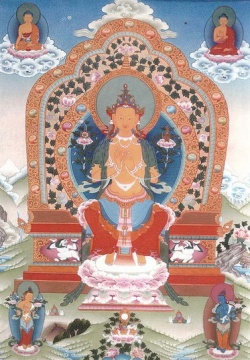Maitreya, Buddha of the Future
Maitreya's association is with the Sun god Mitra. It is around him that the light cults came into being. They are represented by Amitabha, Vairocana and Maitreya. He is also one of the Buddhas of the three times. Dipankara is the Buddha of the past, Shakyamuni of the present, and Maitreya of the future. Maitreya is said to be waiting for the time when he will descend to earth. He is the hope of civilization expressing the invisible future by means of the visible. He confers happiness.
There are a variety of forms of Maitreya. He may be portrayed sitting or standing, displaying various combinations of mudras and attributes. His cult was popular in the early centuries of the Christian era. Devotees hope to be reborn in his paradise. The conception of him as the Future Buddha, endowed them with hope that if reborn they would be redeemed by his teachings.
Maitreya is peaceful and resplendent, he is typically depicted seated in lalita asana with both legs hanging, he holding a twig of nagakesara flower in his right hand and a miniature chaitya ornament in his hair. His heaven is called Tushita. In Tibet he is also represented as a Bodhisattva sitting in bhadrasana, wearing ornaments and a crown. Pendent legs indicate his readiness to descend on the earth, to establish the lost truth in all purity. Both of his hands may be in the teaching gesture or may hold a lotus, a chakra or a vase.
Two scholars flank Maitreya: Asanga and Vasubandhu. A Japanese philosopher of the Tendai school has said that the sunlight of Shakyamuni has been hidden in the distant clouds and we have not yet seem the glimpse of the moonlight of the merciful future Buddha, Maitreya. Maitreya descends from heaven and comes in a cloud featured like a rainbow. The ray of Maitreya that comes down from the top splits into five different colours, touches Asanga and ends its course in a white flame. So Asanga is white, an expression of his illumined consciousness. Asanga was a professor at Nalanda and spent much time in Ayodhya, a center of learning. His younger brother was Vasubandhu. Vasubandhu was a scolar of philosophy. Their distinctive personalities are brought out in thangka paintings. Asanga is calm and serene while Vasubandhu is energised thought.
Maitreya, the Future Buddha was also popular in Theravada Buddhist countries. His image can be found in paintings and sculptures in Sri Lanka, Burma and Thailand.
